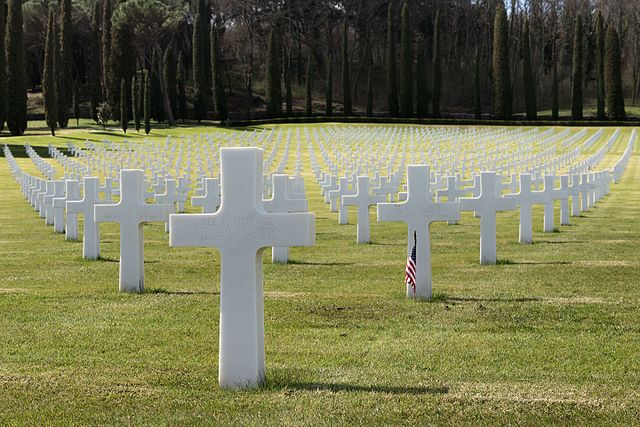
The Works Of Corporal Mercy – Burying The Dead
The Works of Mercy recommended by the Church do not have priority over one another, but all are of equal importance
It is a funeral that Courbert, a French painter at odds with the idealist academic tradition of his time, shows us in his large painting (6m.X3m.) of 1849, kept at the Musée d’Orsay. This is how the burial of a deceased person usually begins, and Courbert (1818/1887) portrayed 50 people from his village in Ornans to make it, trying to identify the various attitudes that commonly animate the participants in funeral ceremonies. Here they are all ordinary people like the deceased whose coffin is barely visible, covered by a white cloth, near a grave a skull and crucifix almost shyly towering over the group. The colors are earthy, dark, mellow, the light diffuse and indefinite, highlighting well the physicality of the figures arranged in a single horizontal mass, overhung by a yellowish color that fades with the gray-green of the sky. Regarded as the initiator of realism, Courbert had very heavy criticism especially for this painting considered as a tribute to vulgarity and ugliness because it was decidedly opposed to the ideals of classicism and romanticism.
He also presents us with reality for what it is without embellishments in stark contrast to the bourgeois culture of the time, uncomfortably downplaying the importance of ritual. Indeed, Courbert investigates the psychology of the characters, and as is still the case today, he notes the chattering of some, the lack of participation in the pain, those who turn to observe others, those who are present for convenience. Unaware of what is happening are the altar boys who ask for explanations or remain as indifferent as the serious priest in performing the rite. Standing out among the crowd set before a rough landscape are the conspicuously red-clad priests, the dark gowns, the women’s white bonnets, and the stray dog approaching the group, revealing the verisimilitude of a common human activity.

Of quite a different spiritual intensity is the “Burial of the Body of Christ” executed in 1602/1606, now in the Borghese Gallery, by Flemish painter Peter Paul Rubens (1577/1640). Here, too, the author makes a careful psychological investigation of the characters, but they reveal an intense participation in the event, and seem to bring the viewer into this drama of death. Rubens greatly admired Caravaggio’s painting of the same subject and, within a year of Caravaggio’s death in 1610, elaborated it in Antwerp away from the original work. The son of Protestants, he converted to Christianity at the age of 14 and began his apprenticeship in local workshops before being appointed master of the Antwerp Guild of Painters. He soon had large commissions from nobles in France, Spain, and Italy and died in Antwerp.
Rubens in this work arranges a large dark arch at the top, a symbol of death, makes Christ a heavy human body that is placed in the tomb almost begrudgingly. Letting him go is the young s. John intent on supporting the Virgin who, grieving turns her gaze upward, as if asking for help in performing an action as difficult as it is painful. Christ, strongly illuminated, shows the bruises of torture, while the old man on the right, could be Nicodemus with the face of St. Philip Neri. The latter, turning his wrinkled gaze, seems to want to express the difficulties that arose in the execution of the burial, and the procedure involved. The light decisively strikes the beautiful face of Christ, of the Magdalene in an almost disheveled attitude, perhaps as a reminder of her past, leaving the other characters more in shadow, to enhance that tragic moment and respect the deep pain experienced by all the characters. The whole drama is softened by the warm colors, contrasting with the darker, but muted colors that contrast with the white of Christ’s body and shroud, and explain the tragic moment in an engaging way.

Certainly burying the dead is a difficult task to accomplish, and especially in recent times, it is the sea that fulfills this task. How many times have we heard about these victims of the sea: fishermen or immigrants. Lorenzo Viani, a well-known contemporary Viareggio artist, reflects on this very issue and leaves us a very significant work, “Blessing of the Dead of the Sea” from 1914/16, in the Viareggio museum. The real protagonist is the grief of the women who stand side by side composed in resigned acceptance as they hold their now orphaned children. The compact black color of their robes brings out these faces now masks of grief, among which stands out a youthful, sweet face almost reminiscent of the face of the Madonna. Black figures before a dark gray sea, barely marked by a few small white waves, who waited confidently, reciting the rosary for the return of their loved ones, whom they will never see again. Traditions sustained by faith, regulated by the inexorable passing of time, are expressed by the author with strong chromaticism, flat volumes, with a rigidly geometric compositional structure.

The tragedy, the anguish of waiting, the joining of hands, the embrace of the shipwrecked man, the clasping of the children to themselves, already resigned to the tragic fate, generates overwhelming emotions. The Viani writes: “even the sea, exterminated cemetery, was blessed this morning at dawn…. The families of the missing gather around the little church… the priest raises his arm and the blessing drizzles over the sea of lead.” Images and words effectively summarize the reality of this latest work of corporal mercy, which invites all to reflection.
